
The pear tree and shrub are a species of genus Pyrus, in the family Rosaceae, bearing the pomaceous fruit of the same name. Several species of pear are valued for their edible fruit and juices while others are cultivated as trees.
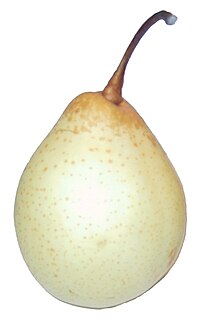
Pyrus × bretschneideri, the ya pear or pearple or Chinese white pear, is an interspecific hybrid species of pear native to North China, where it is widely grown for its edible fruit.
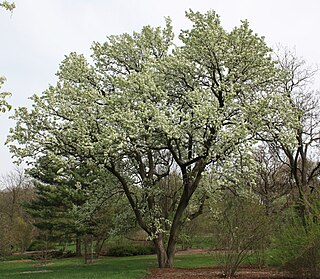
Pyrus calleryana , or the Callery pear, is a species of pear tree native to China and Vietnam, in the family Rosaceae. It is most commonly known for its cultivar 'Bradford', widely planted throughout the United States and increasingly regarded as an invasive species.

Pyrus communis, known as the European pear or common pear, is a species of pear native to central and eastern Europe and southwest Asia.

Pyrus salicifolia is a species of pear, native to the Middle East. It is widely grown as an ornamental tree, almost always as a pendulous cultivar, and is called by various common names, including willow-leaved pear, weeping pear, and similar. The tree is deciduous and of comparatively small stature, rarely reaching 10–12 meters in height. The crown is rounded. It has pendulous, silvery foliage, superficially similar to a weeping willow. The flowers are large and pure white highlighted with black-tipped stamens although the buds are tipped with red. The small green fruits are inedible, being hard and astringent.
In botanical nomenclature, a hybrid may be given a hybrid name, which is a special kind of botanical name, but there is no requirement that a hybrid name should be created for plants that are believed to be of hybrid origin. The International Code of Nomenclature for algae, fungi, and plants (ICNafp) provides the following options in dealing with a hybrid:
Pyrus anatolica is a species of plant in the family Rosaceae. It is endemic to Turkey.
Pyrus hakkiarica is a species of plant in the family Rosaceae. It is endemic to Turkey.
Pyrus oxyprion is a species of plant in the family Rosaceae. It is endemic to Turkey.

Pyrus pyraster, also called European wild pear, is a species of pear belonging to the Rosaceae family.
Pyrus boissieriana, the Boissier pear and telka, is a species of Pyrus - pear native to the Kopet Dag region on the Turkmenistan and Iranian border. In its native locales it is cultivated as a rootstock for domestic pears.
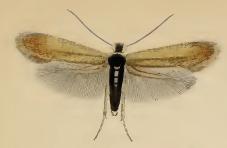
Stigmella minusculella is a moth of the Nepticulidae family. It is found from Denmark and Latvia to the Pyrenees, Corsica, Italy and Crete, and from Great Britain to Ukraine. It is also present in North America, where it is found in Ohio, New Jersey and Ontario.
The unspotted tentiform leafminer moth is a moth of the family Gracillariidae. It is known from Québec, Canada, and Florida, Georgia, Maine, Maryland, New York, Vermont, Texas, Colorado, Missouri, Kentucky and Connecticut in the United States.

Pyrus pashia, the wild Himalayan pear, is a small to medium size deciduous tree of the small and oval shaped crown with ovate, finely toothed leaves, attractive white flowers with red anthers and small pear-like fruits. It is a fruit bearing tree that is native to southern Asia. Locally, it is known by many names such as batangi (Urdu), tangi (Kashmiri), mahal mol (Hindi) and passi (Nepal).
Pyrus cordata, the Plymouth pear, is a rare wild species of pear belonging to the family Rosaceae. It gets its name from the city of Plymouth in Devon, where it was originally found in 1870 The Plymouth pear was one the British trees to be funded under English Natures Species Recovery Programme.
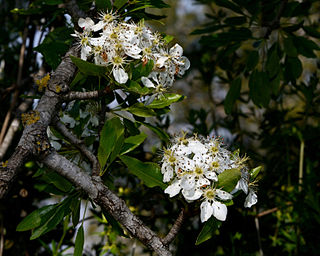
Pyrus syriaca, the Syrian pear, is a deciduous tree of the Rose family. It is the only pear species which grows in the wild in Lebanon, Turkey, Syria and Israel.

Pyrus amygdaliformis, also known as the almond-leaved pear, is a species of plant in the family Rosaceae. It is native to southern Europe, the Mediterranean, and west Asia. It grows to a height of 3–10 metres (9.8–32.8 ft). It has white flowers which bloom in April–May. The fruits are bitter and astringent. It hybridizes well with Pyrus communis and Pyrus pyraster.
Pyrus armeniacifolia, also known as the apricot-leaved pear, is a species of plant in the family Rosaceae. It is known from northern Xinjiang, where it is cultivated near Tacheng.

Pyrus ussuriensis, also known as the Ussurian pear, Harbin pear, and Manchurian pear, is a species of flowering plant in the family Rosaceae.
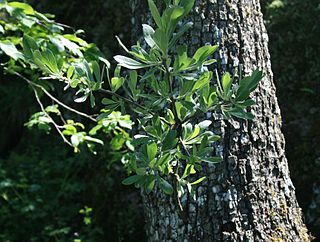
Pyrus elaeagrifolia, the oleaster-leafed pear, is a species of wild pear plant in the genus Pyrus (Rosaceae), the specific name referring to the similarity of its foliage to that of Elaeagnus angustifolia - the so-called 'wild olive' or oleaster.














